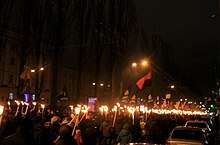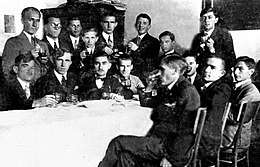Banderites
The Banderivtsi (Ukrainian: Бандерівці, Bandе́rivtsi or bandе́rovtsy, Polish: banderowcy, Russian: Бандеровцы) are members of an assortment of right-wing organizations in Ukraine.

The term derives from the name of Stepan Bandera (1909-1959), head of the Organization of Ukrainian Nationalists that formed in 1929 as an amalgamation of movements including the Union of Ukrainian Fascists.[1][2] The union, known as OUN-B, had been engaged in various atrocities, including murder of civilians, predominantly Jews and Poles under the Nazi German administration.[3][4] The term Banderites was also used by the Bandera followers themselves, and by others during the Holocaust, and the massacres of Poles and Jews in Volhynia and Eastern Galicia by OUN-UPA in 1943–1944.[5]
According to Timothy D. Snyder nowadays the word is used (often pejoratively) to denote Ukrainian nationalists who sympathize with the fascist ideology, and consider themselves followers of the OUN-UPA myth in modern Ukraine.[6]
History

The first murder operation carried out by OUN with the active participation of the then 25-year-old Bandera was the assassination of Bronisław Pieracki, Poland's Minister of Interior, in June 1934. Bandera provided the assassin with the 7.65mm caliber pistol personally.[7] His subsequent arrest and conviction turned Bandera into an instant legend among the militant Ukrainian nationalists of the Second Polish Republic. Bandera, who escaped from prison after the German invasion of Poland in September 1939, offered his services to Nazi Germany in exchange for an ongoing financial and logistical support.[8] Several months before the German attack on the USSR, in February 1941 Bandera became the leader (Providnyk) of the faction of OUN known as OUN-B, or the Banderivtsi. In July 1941 however Bandera himself was arrested and sent to a concentration camp in Germany, which he left only in 1944.
Subsequently, the OUN-B formed Ukrainian death-squads which carried out pogroms and massacres without any encouragement or help from the Germans.[9][8]
To ensure maximum impact of the systematic ethnic cleansing campaign in the contested territory, OUN-B faction spread antisemitic, racist, and fascist propaganda among the ordinary peasants and other Ukrainians.[9]:235-236 Aided by Stetsko, Shukhevych, and Lenkavskyi (OUN-B propaganda chief), Bandera wrote a manifesto titled "Ukrainian National Revolution" that called for the annihilation of so-called ethnic enemies. The manifesto informed the locals how to act, and included specific instructions about the killing of Jews, Poles, and Ukrainian opponents of fascism.[9]:237[10] Bandera coordinated the pogroms from behind. He did not participate in them; he remained in the area of occupied Kholmshchyna (Polish Chełm Land) further north-west.[9]:237
The vast majority of pogroms carried out by the Banderites occurred in Eastern Galicia and Volhynia, but also in Bukovina.[9]:237 The most deadly of them was perpetrated in the city of Lviv by the people's militia formed by OUN with direct participation of civilians, at the moment of the German arrival in the Soviet-occupied eastern Poland.[11] There were two Lviv pogroms, carried out in a one-month span, both lasting for several days; the first one from 30 June to 2 July 1941, and the second one from 25 to 29 July 1941.[12] The first pogrom took the lives of at least 4,000 Jews.[13] It was followed by the killing of 2,500 to 3,000 Jews by the Einsatzgruppe C,[14] and the "Petlura Days" massacre of more than 2,000 Polish Jews by the Ukrainian militants.[13][15] During the pogrom, on June 30, 1941 Bandera declared a sovereign Ukrainian state in Lviv, and a few days later was arrested by the Germans who opposed it. Bandera was sent to detention in Germany. His supporters took over the command of the UPA death squads two years later, in November 1943.[2][8]
References
- Rudling, Per A. (November 2011). "The OUN, the UPA and the Holocaust: A Study in the Manufacturing of Historical Myths". Number 2107. University of Pittsburgh: The Carl Beck Papers in Russian & East European Studies. p. 3 (6 of 76 in PDF). ISSN 0889-275X. Cite journal requires
|journal=(help) - Cooke, Philip; Shepherd, Ben (2014). Hitler's Europe Ablaze: Occupation, Resistance, and Rebellion during World War II. Skyhorse Publishing. p. 336. ISBN 1632201593.
- Lower, Wendy; Faulkner Rossi, Lauren (2017). Lessons and Legacies XII: New Directions in Holocaust Research and Education. Northwestern University Press. pp. 170–171, 174. ISBN 0810134500.
The victims of the Holocaust had a difficult time identifying precisely who intended to murder them; the usual terminology was "Banderites," which indicated adherents of a particular political tendency, or "Bulbas," which indicated the insurgent force initiated by Taras Bulba-Borovets.[p. 174]
- Risch, William Jay (2011). The Ukrainian West: Culture and the Fate of Empire in Soviet Lviv. Harvard University Press. pp. 55, 65, 69. ISBN 0674061268.
- Rossoliński-Liebe, Grzegorz (2016). "Stepan Bandera, Dr. Andrii Portnov, and the Holocaust: Is the Bandera Myth Detached from the Person?". The American Association for Polish-Jewish Studies. Retrieved 2016-04-23.
[Andrii Portnov's article from the Frankfurter Allgemeine Zeitung (8 January 2016)] informs the readers about the use of the term Banderites in Soviet propaganda, but he [Portnov] forgets to mention that the OUN members did call themselves such and regarded Bandera as their leader when they were murdering Jews during the pogroms in summer 1941 and when they, in the uniforms of the Ukrainian police, were helping the Germans to shoot Jews in 1942 and 1943. He also ignores the fact that Ukrainian nationalists perceived themselves as Banderites and were perceived as such by others during the ethnic cleansings of the Polish population in Volhynia and eastern Galicia. Finally, he does not inform the readers that Bandera never condemned the atrocities committed by the OUN and UPA.
- Snyder, Timothy (February 24, 2010). "A Fascist Hero in Democratic Kiev". The New York Review of Books.
- Żeleński, Władysław (1973). The Assassination of Minister Pieracki [Zabòjstwo ministra Pierackiego]. Poland: Institut Literacki. pp. 20–22, 72. Biblioteka "Kultury" volume 233.
- Motyl, Alexander J. (2000). Encyclopedia of Nationalism. Two-Volume Set. Elsevier, Academic Press. p. 40. ISBN 0080545246. With over one hundred contributors.
On February 10, 1941, Bandera called a conference of radicals in Kraków, Poland. The conference refused to accept Melnyk as leader, and named Bandera head of the OUN. This led to the split of the OUN in the spring of 1941 into two groups: OUN-B (Banderites), who were more militant, younger and supported Bandera, and OUN-M (Melnykites), who were generally older, more ideological.
- Rossolinski, Grzegorz (2014). Stepan Bandera: The Life and Afterlife of a Ukrainian Nationalist: Fascism, Genocide, and Cult. Columbia University Press. pp. 112, 234–235, 236. ISBN 3838266846.
The OUN-B organized a militia, which both collaborated with the Germans and killed Jews independently.
- Piotrowski, Tadeusz (1998). Poland's Holocaust: Ethnic Strife, Collaboration with Occupying Forces and Genocide in the Second Republic, 1918–1947. Jefferson, NC: McFarland & Company. p. 209. ISBN 0-7864-0371-3. OCLC 37195289.
OUN leaflets appeared on the city streets. They read: "Exterminate the Poles, Jews and communists without mercy. Do not pity the enemies of the Ukrainian National Revolution!"
CS1 maint: ref=harv (link) - Prof. John-Paul Himka (25 February 2013). "A few more words about the Lviv pogrom" [Ще кілька слів про львівський погром]. IstPravda.com.ua. Історична правда. With links to relevant articles. For the English original, see: John-Paul Himka (2011). "The Lviv Pogrom of 1941: The Germans, Ukrainian Nationalists, and the Carnival Crowd". Canadian Slavonic Papers. 53 (2–4): 209–243. ISSN 0008-5006.. Archived from the original on 4 March 2016.
- Himka, John-Paul (2011). "The Lviv Pogrom of 1941: The Germans, Ukrainian Nationalists, and the Carnival Crowd". Canadian Slavonic Papers. Vol. 53 (2–4): 209–243. ISSN 0008-5006.
- USHMM. "Lwów". The Holocaust Encyclopedia. United States Holocaust Memorial Museum. Archived from the original (Internet Archive) on 2012-03-07.
- N.M.T. (1945). "Trials of War Criminals before the Nuernberg Military Tribunals" (PDF). Volume IV : "The Einsatzgruppen Case" complete, 1210 pages. Nuremberg Military Tribunals under Control Council Law No. 10: 542–543 in PDF (518–519 in original document) – via PDF direct download.
With N.M.T. commentary to testimony of Erwin Schulz (p. 543 in PDF).
- Longerich, Peter (2010). Holocaust: The Nazi Persecution and Murder of the Jews. Oxford; New York: Oxford University Press. p. 194. ISBN 978-0-19-280436-5.
Further reading
| Wikimedia Commons has media related to Stepan Bandera commemoration. |
- Valeriy Smoliy (1997), "Small dictionary of Ukrainian history" — Lybid.
- G. Demyian — "Banderivtsi" — Ternopil dictionary encyclopedia – G. Iavorskiy — "Zbruch", 2004-2010, 696p. ISBN 966-528-197-6.